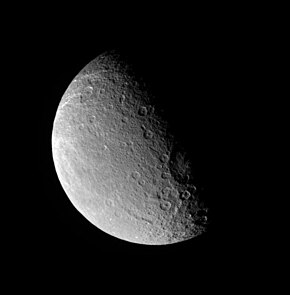Tirawa is the largest impact basin on Saturn's moon Rhea. It was glimpsed by Voyager 1 during its flyby of the moon and later photographed in greater detail by the Cassini orbiter. Tirawa is elongated in shape and overlaps Mamaldi, a larger and more degraded basin to its southwest.[3]
 This Cassini image of Rhea shows Tirawa straddling Rhea's terminator | |
| Feature type | Peak-ring impact basin |
|---|---|
| Location | Leading hemisphere, Rhea |
| Coordinates | 34°12′N 151°42′W / 34.200°N 151.700°W[1] |
| Diameter | ~350 km (220 mi)[2] |
| Depth | ~6 km (3.7 mi)[2] |
| Discoverer | Voyager 1 |
| Eponym | Tirawa |
Observation and naming
Tirawa was first observed by the Voyager 1 as it captured imagery of Rhea during its flyby of the Saturn system on 13 November 1980. Though poorly imaged from the Voyager 1 encounter, Tirawa was identified as an impact structure by 1983 and provisionally named Basin A.[4][3] Tirawa was later named after the primary deity in Pawnee mythology, Tirawa; the name was officially approved by the International Astronomical Union (IAU) in 1987.[1] Tirawa was later observed in greater detail by the Cassini orbiter in multiple flybys of Rhea throughout the late 2000's and the 2010's.
Geology
With a rough diameter of 350 kilometers, Tirawa is the largest identified impact structure on Rhea. Tirawa is a peak-ring impact basin, with a degraded inner ring of ridges and plateaus roughly 180 kilometers across. Individual ridges in the peak ring are typically ~50 kilometers across at their base and rise 1–3 kilometers above the basin floor. Tirawa is slightly elongated into an ellipsoid, with an a/b ratio of ~0.9, indicating that it was created in a low-angle oblique impact. Based on the crater counting method, Tirawa is about 4 billion years old.[2][4]
The impact event that created Tirawa ejected massive amounts of material, with up to ~15-20% of the material ejected at speeds exceeding Rhea's escape velocity.[2] Any such impact ejecta would've escaped Rhea's influence entirely, directly orbiting Saturn. Some of the ejecta later impacted Rhea, likely accounting for a large amount of Rhea's small craters.[5]